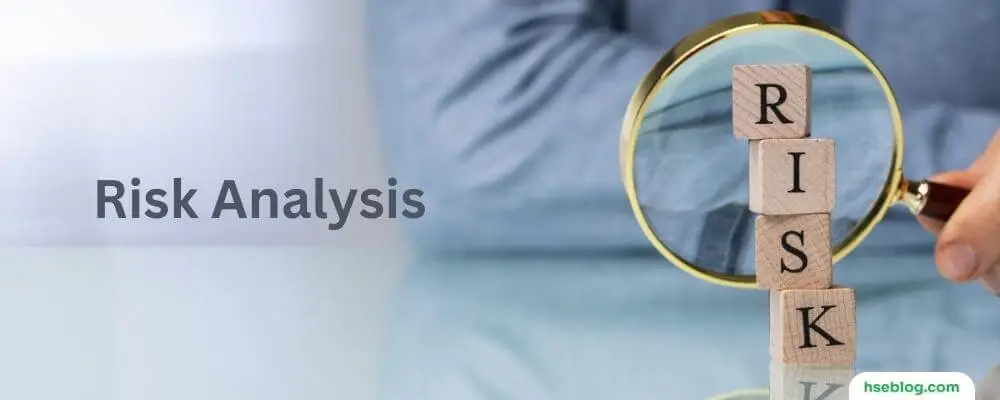Understanding the possible risks that can impact an organization’s objectives or operations is vital for strategic decision-making. Risk analysis, an indispensable element in the toolkit of every successful business, is a process designed to comprehend these risks. In this blog post, ‘What is Risk Analysis? Process, Types, Examples & Methods’, we delve into the depths of risk analysis, unraveling its nuances and components. We’ll explore the various types of risk analysis and its diverse methods, interspersing our discussion with relevant industry examples.
We’ll also illustrate the process, giving you a well-rounded view of risk analysis. Whether you’re a seasoned professional or a newcomer to this field, our post aims to equip you with valuable insights to comprehend and effectively apply risk analysis in your business context. So let’s navigate the maze of risk analysis together, starting with its definition and purpose.
What is Risk Analysis?
Risk analysis is a technique used to identify and assess factors that may jeopardize the success of a project or achieving a goal. This process evaluates the risks involved and quantifies the severity of each potential hazard to determine the best course of action.
In the context of business or projects, this might include any operational risk, financial risk, strategic risk, or environmental risk that could be faced. These risks are then assessed for their potential impact and likelihood of occurrence, informing the decision-making process, allowing businesses or project managers to plan and prepare for potential issues, and reducing their negative impact.
Risk analysis is part of the broader practice of risk management and it helps to ensure project predictability and success by proactively identifying potential pitfalls. The aim of a risk analysis is to make sure that you have contingency plans in place if specific scenarios were to occur. It’s an important part of planning for businesses, projects, or personal finances and investments.

Types of Risk Analysis
As risk analysis covers a wide range of topics, there are many approaches to analyzing risks or types of risk analysis. These include, but are not limited to, the following:
1. Risk-Benefit & Cost-Benefit Analysis
These are two different but related types of analysis. In risk-benefit analysis, the potential benefits of a decision or action are weighed against the potential risks. It’s not just about the financial considerations but about the potential positive and negative outcomes, such as improved customer satisfaction or potential harm to the company’s reputation.
On the other hand, cost-benefit analysis is more financially focused. It involves calculating the total expected cost of a project or decision (including both direct and indirect costs), and comparing this to the expected benefits (usually in terms of financial gain or cost savings). Both types of analysis help decision-makers make informed choices about whether a certain project or decision is worth pursuing.
2. Needs Assessment
This is a process of determining and addressing gaps between current and desired conditions or “needs.” The assessment could be used for various areas, such as improving product quality, employee performance, or operational efficiency. The ultimate goal is to align resources and strategies to effectively meet the organization’s goals and objectives. It involves identifying areas of improvement, analyzing potential solutions, and implementing plans to bridge the gap.
3. Business Impact Analysis (BIA)
This is a systematic process to determine and evaluate the potential effects of an interruption to critical business operations due to a disaster, accident, or emergency. BIA is an essential component of an organization’s business continuity plan; it includes an exploratory component to reveal any vulnerabilities and a planning component to develop strategies for minimizing risk. The result is a business impact analysis report describing the potential risks specific to the organization.
4. Failure Mode and Effects Analysis (FMEA)
This is a step-by-step approach for identifying all possible failures in a design, a manufacturing or assembly process, or a product or service. It’s used to analyze the potential failure points within a system for classification by severity or determination of the effect of failures. By anticipating and identifying these potential points of failure, the organization can take proactive steps to mitigate the risks associated with the failure, thus enhancing reliability and safety.
5. Root Cause Analysis (RCA)
This is a method of problem-solving used for identifying the root causes of faults or problems. The principle behind RCA is to correct the root causes of problems or events instead of simply addressing their symptoms. This typically involves a sequence of steps to collect data, analyze it, identify root causes, and implement improvements. Tools like the “5 Whys” and “Fishbone Diagrams” are often used in RCA. When root causes are eliminated, it prevents the final undesirable effect from recurring.

Risk Analysis Methods
Qualitative and quantitative risk analyses represent two fundamental approaches to understanding and mitigating risks within a context or system.
Qualitative Risk Analysis relies on the subjective judgment of experts to evaluate and prioritize risks. It often involves rating or scoring risks based on the perceived severity of their impact and the likelihood of occurrence. A common tool utilized in this method is the Risk Assessment Matrix or Risk Matrix, which graphically represents the severity and likelihood of risks on a grid, commonly 3×3, 4×4, or 5×5. This method can be beneficial for its simplicity and ability to provide a high-level view of potential risks.
Various types of qualitative analyses include Root Cause Analysis (RCA), which focuses on identifying the fundamental source of a problem to prevent its recurrence, and Needs Assessment, which systematically identifies and evaluates an organization’s requirements or gaps.
On the other hand, Quantitative Risk Analysis provides a more statistically rigorous approach, using numerical and data-driven methodologies to calculate risks. This analysis systematically uses data to estimate the probability and consequences of risks and thus requires more detailed information and resources than its qualitative counterpart.
Types of quantitative analysis include Business Impact Analysis (BIA), which calculates the potential effects of an interruption to critical business operations, and Failure Mode and Effects Analysis (FMEA), a procedure that examines potential failures in a system and the impact of those failures. Additionally, Risk-Benefit Analysis falls into this category, balancing the potential harms (risks) and advantages (benefits) associated with each decision or action.
The outcomes of these methods are different: qualitative analysis results in projected risks, which are educated estimations of how the risk may appear, whereas quantitative analysis results in statistical risks, which are specific, data-backed outcomes. Statistical risks are typically used in precise calculations such as insurance premiums due to their rigorous, data-driven nature.

Risk Analysis Process
The risk analysis is a systematic approach that identifies, analyzes, and evaluates potential risks that could impact an organization’s operations and objectives. This process follows these key steps:
1. Conducting a Risk Assessment Survey
The first step of the risk analysis process involves gathering insights from key personnel like management and department heads via a risk assessment survey. This is vital as it helps identify each department’s risks or threats. A survey is a tool for initiating the documentation of specific risks within the organization, providing an inclusive view that considers insights from various perspectives.
2. Identifying the Risks
Following the survey, the next step entails evaluating significant aspects of the organization, such as the IT system. Here, the objective is to recognize and question potential risks related to the system’s software, hardware, data, and human resources. This step also involves predicting potential adverse events – be it human errors, natural disasters like floods or earthquakes, or other threats – that could compromise the integrity or availability of the system.
3. Analyzing the Risks
Once the potential risks are recognized, the subsequent stage of risk analysis involves determining the likelihood of occurrence for each risk, the potential consequences associated with each risk, and the implications these might have on the organization’s objectives. This analysis provides a risk profile, giving decision-makers an idea of what could go wrong and how severe the impact could be.
4. Developing a Risk Management Plan
The next step is to create a comprehensive risk management plan. This plan is formulated based on analyzing valuable assets and the threats that could impact them negatively. The risk analysis should produce control recommendations that can be used to mitigate, transfer, accept, or avoid the identified risks. This plan essentially defines how the organization can reduce its risk exposure.
5. Implementing the Risk Management Plan
With a plan in place, the focus now shifts to execution. The primary objective of risk assessment is to implement measures that can eliminate or at least reduce the risks. Starting with the highest-priority risk, each identified risk should be addressed to ensure it no longer poses a threat. This involves applying the strategies outlined in the risk management plan.
6. Monitoring the Risks
The final stage of the risk analysis process involves continually identifying, treating, and managing risks. It’s important to remember that risk management is not a one-time process but requires ongoing monitoring. This accounts for new or changing risks and ensures that mitigation strategies remain effective.
Remember that the focus of the risk analysis and the presentation of results will vary depending on the type of risk analysis being performed and the organization’s specific needs and nature.

Risk Analysis Examples
Risk analysis is crucial in different industries and sectors, allowing them to make informed decisions and prepare for uncertainties. Here are a few examples of how risk analysis can be applied:
Healthcare Risk Analysis Example
In a large hospital, the medical director is assessing the introduction of a new surgical procedure. The procedure has the potential to greatly improve patient outcomes, but being relatively new, there are risks associated with its implementation. A detailed qualitative risk analysis is conducted, which considers risks such as the training requirements for staff, the potential for complications during surgery, and the hospital’s liability in case of any unforeseen circumstances.
By categorizing and ranking these risks based on their severity and likelihood of occurrence, the hospital can effectively prioritize its risk mitigation strategies and decide whether to introduce the new surgical procedure.
Manufacturing Risk Analysis Example
A new manager in a manufacturing plant is preparing for a surge in orders due to the upcoming summer season. He needs to ensure the factory can cope with the increased demand. He initiates a needs assessment to understand the necessary changes for efficient production. The workers are asked to complete a survey about the factory’s existing processes, highlighting any bottlenecks or areas of concern.
The survey’s insights help the manager identify areas of improvement, anticipate potential problems, and prepare strategies for maximizing productivity while maintaining quality. This detailed needs assessment aids the manager in devising an effective plan to handle the increased demand during the summer season.
Transport & Logistics Risk Analysis Example
A director at a multinational shipping company is concerned about the operational disruption an impending storm might cause. She proposes setting aside funds for recovery post-storm, but her colleague disagrees, believing the storm’s impact would be minimal.
She undertakes a business impact analysis to validate her concerns and persuade the board. This comprehensive analysis considers the potential impacts on shipping routes, delays in delivery, potential damage to goods, and the subsequent effects on customer satisfaction and revenue. The results, presented at the next board meeting, provide quantifiable data to substantiate her argument and guide the board’s decision-making process.

Construction Risk Analysis Example
In this scenario, a construction company owner is considering a proposal to construct a luxury resort. While the company has a solid reputation for mid-range residential buildings, this would be its first venture into luxury resort construction. The potential for positive media coverage is appealing, but the risks of venturing into a new sector are significant.
The owner conducts a risk-benefit analysis with her team to make an informed decision. This involves assessing potential benefits like increased visibility and potential new business against the risks, such as cost overruns, unfamiliarity with luxury construction standards, and the possibility of damaging the company’s reputation if the project fails. The detailed evaluation assists her in determining whether the advantages outweigh the potential risks, facilitating an informed decision-making process.
Conclusion
In conclusion, risk analysis is critical in strategic decision-making for any organization spanning various industries. It allows us to understand and manage potential problems that could undermine key business initiatives or projects. Businesses can effectively anticipate potential threats and opportunities by employing a systematic approach, using various types of risk analysis – from qualitative to quantitative- and applying various methods. It’s a dynamic process that requires regular reviews and updates as circumstances change.
Through practical examples, we’ve seen how risk analysis plays out in different scenarios and how instrumental it is in guiding strategic decisions. Remember, the goal of risk analysis isn’t to eliminate risk entirely – an impossible task – but rather to provide the tools and insights necessary to understand and manage risk effectively. By doing so, businesses can minimize their vulnerabilities, capitalize on opportunities, and navigate to success amidst an ever-evolving landscape of uncertainties.

